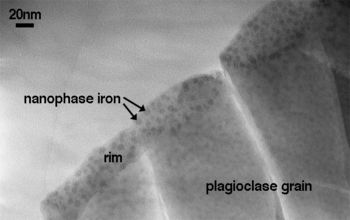Space weathering
Space weathering is the type of
- collisions of solar cosmic rays,
- irradiation, implantation, and sputtering from solar wind particles, and
- bombardment by different sizes of micrometeorites.
Space weathering is important because these processes affect the physical and optical properties of the surface of many planetary bodies. Therefore, it is critical to understand the effects of space weathering in order to properly interpret remotely sensed data.

History
Much of our knowledge of the space weathering process comes from studies of the lunar samples returned by the
The first products of space weathering that were recognized in lunar soils were "agglutinates". These are created when micrometeorites melt a small amount of material, which incorporates surrounding glass and mineral fragments into a glass-welded aggregate ranging in size from a few micrometers to a few millimeters. Agglutinates are very common in lunar soil, accounting for as much as 60 to 70% of mature soils.[1] These complex and irregularly-shaped particles appear black to the human eye, largely due to the presence of nanophase iron.
Space weathering also produces surface-correlated products on individual soil grains, such as glass splashes; implanted
These weathering processes have large effects on the spectral properties of lunar soil, particularly in the

Effects on spectral properties
On the Moon, the spectral effects of space weathering are threefold: as the lunar surface matures it becomes darker (the albedo is reduced), redder (reflectance increases with increasing wavelength), and the depth of its diagnostic absorption bands are reduced[4] These effects are largely due to the presence of nanophase iron in both the agglutinates and in the accreted rims on individual grains. The darkening effects of space weathering are readily seen by studying lunar craters. Young, fresh craters have bright ray systems, because they have exposed fresh, unweathered material, but over time those rays disappear as the weathering process darkens the material.
Space weathering on asteroids
Space weathering is also thought to occur on asteroids,
However, we do see evidence for asteroidal space weathering. For years there had been a so-called "conundrum" in the planetary science community because, in general, the spectra of asteroids do not match the spectra of our collection of meteorites. Particularly, the spectra of
There is evidence to suggest most of the color change due to weathering occurs rapidly, in the first hundred thousands years, limiting the usefulness of spectral measurement for determining the age of asteroids.[9]
Space weathering on Mercury
The environment on Mercury also differs substantially from the Moon. For one thing, it is significantly hotter in the day (diurnal surface temperature ~100 °C for the Moon, ~425 °C on Mercury) and colder at night, which may alter the products of space weathering. In addition, because of its location in the Solar System, Mercury is also subjected to a slightly larger flux of micrometeorites that impact at much higher velocities than the Moon. These factors combine to make Mercury much more efficient than the Moon at creating both melt and vapor. Per unit area, impacts on Mercury are expected to produce 13.5x the melt and 19.5x the vapor than is produced on the Moon.[10] Agglutinitic glass-like deposits and vapor-deposited coatings should be created significantly faster and more efficiently on Mercury than on the Moon.
The UV/Vis spectrum of Mercury, as observed telescopically from Earth, is roughly linear, with a red slope. There are no absorption bands related to Fe-bearing minerals, such as pyroxene. This means that either there is no iron on the surface of Mercury, or else the iron in the Fe-bearing minerals has been weathered to nanophase iron. A weathered surface would then explain the reddened slope.[11]
See also
References
- ISBN 978-0-521-33444-0.
- .
- hdl:2060/20070019675.
- ISSN 0148-0227.
- ..
- S2CID 33807424.
- S2CID 5326244.
- S2CID 4353389.
- ^ Rachel Courtland (30 April 2009). "Sun damage conceals asteroids' true ages". New Scientist. Retrieved 27 February 2013.
- ISSN 0148-0227.
- .
Further reading
- Linda Martel (July 5, 2004). "New Mineral Proves an Old Idea about Space Weathering". Planetary Science Research Discoveries.
- "Workshop on Space Weathering of Airless Bodies" (PDF). .

